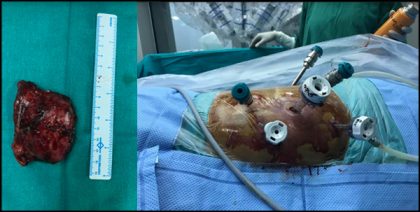- Home
- Editorial
- News
- Practice Guidelines
- Anesthesiology Guidelines
- Cancer Guidelines
- Cardiac Sciences Guidelines
- Critical Care Guidelines
- Dentistry Guidelines
- Dermatology Guidelines
- Diabetes and Endo Guidelines
- Diagnostics Guidelines
- ENT Guidelines
- Featured Practice Guidelines
- Gastroenterology Guidelines
- Geriatrics Guidelines
- Medicine Guidelines
- Nephrology Guidelines
- Neurosciences Guidelines
- Obs and Gynae Guidelines
- Ophthalmology Guidelines
- Orthopaedics Guidelines
- Paediatrics Guidelines
- Psychiatry Guidelines
- Pulmonology Guidelines
- Radiology Guidelines
- Surgery Guidelines
- Urology Guidelines
Indian doctors remove a large tumor through robotic surgery in a 14-year-old child

In what is touted to be first of its kind case in India, the doctors at Sir Ganga Ram Hospital, Delhi, removed a tennis ball sized tumor (pheochromocytoma) from a child and cured his blood pressure with the help of robotic surgery. This is a unique case as robotic surgery is rarely used in children because of the small size of the abdomen, especially for adrenal tumors, which are deep-seated and adjacent to big blood vessels.
A 14-year-old child was presented to the hospital with sweating, palpitations, breathlessness and high blood pressure. On investigations, he was found to have a large 8 cm tumor in a left adrenal gland, along with high catecholamine (hormone) levels, suggestive of pheochromocytoma.
The case was reported by professor Satish Aggarwal, from the department of pediatric surgery in Sir Ganga Ram Hospital, and colleagues.
The adrenal gland is a deep-seated gland in our abdominal cavity above the kidney, adjacent to biggest blood vessels and important organs of our body. Pheochromocytoma is a rare functional tumor of the adrenal gland which leads to very high blood pressure and other medical problems. It is usually removed by open surgery, which entails a big cut and long recovery.
“This is a very challenging case to manage because of wide variations in blood pressure, a precarious location of the tumor and low reserve in children," said Dr. Aggarwal.

The child was planned for excision of a tumor by robotic surgery, rather than open surgery, in consultation with Dr. Vivek Bindal, a Robotic surgeon at Sir Ganga Ram Hospital. Dr. Bindal said “The location and size of a tumor, its proximity to vital organs like pancreas and major blood vessels, coupled with a small abdominal cavity in a child made it a very challenging and robotic platform was chosen to overcome these problems. The additional benefits of small incisions, minimal blood loss and faster recovery in a child made us proceed with robotics.”
Another challenge was to maintain blood pressure before, during and after surgery. Even minimal manipulation of the adrenal tumor during surgery can shoot the blood pressure to alarming levels, while it falls precipitously immediately after removal of a tumor. Dr. Jayashree Sood, Chairperson, Department of anesthesia said “ This rare tumor required meticulous preoperative preparation. Intra-operatively beat to beat monitoring was done and appropriate drugs were administered as required. After the surgery, the child was managed in the surgical ICU since inotropes needed to be continued to maintain his blood pressure. ”
The child underwent a successful removal of a left adrenal tumor, which turned out to be 8 cm tumor, stuck to kidney, pancreas, spleen and large intestine. Keyhole robotic surgery was performed and the structures were dissected one by one safely. Dr. Bindal said “The tumor was very vascular, and had multiple blood vessels supplying it, arising from renal vessels and aorta. They were isolated and divided in between clips. The tumor was removed in totality without any significant blood loss.”
The procedure lasted for 2 hours. A child was kept in hospital for 4 days and discharged thereafter, without any blood pressure medication. Before surgery, he was taking three different tablets for blood pressure in high doses.
Prof. Aggarwal said that the child was doing well at three weeks follow up. He would keep the child under his able watch.

Disclaimer: This site is primarily intended for healthcare professionals. Any content/information on this website does not replace the advice of medical and/or health professionals and should not be construed as medical/diagnostic advice/endorsement or prescription. Use of this site is subject to our terms of use, privacy policy, advertisement policy. © 2020 Minerva Medical Treatment Pvt Ltd